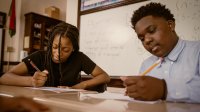3 Simple Strategies to Improve Students’ Problem-Solving Skills
These strategies are designed to make sure students have a good understanding of problems before attempting to solve them.
Research provides a striking revelation about problem solvers. The best problem solvers approach problems much differently than novices. For instance, one meta-study showed that when experts evaluate graphs, they tend to spend less time on tasks and answer choices and more time on evaluating the axes’ labels and the relationships of variables within the graphs. In other words, they spend more time up front making sense of the data before moving to addressing the task.
While slower in solving problems, experts use this additional up-front time to more efficiently and effectively solve the problem. In one study, researchers found that experts were much better at “information extraction” or pulling the information they needed to solve the problem later in the problem than novices. This was due to the fact that they started a problem-solving process by evaluating specific assumptions within problems, asking predictive questions, and then comparing and contrasting their predictions with results. For example, expert problem solvers look at the problem context and ask a number of questions:
- What do we know about the context of the problem?
- What assumptions are underlying the problem? What’s the story here?
- What qualitative and quantitative information is pertinent?
- What might the problem context be telling us? What questions arise from the information we are reading or reviewing?
- What are important trends and patterns?
As such, expert problem solvers don’t jump to the presented problem or rush to solutions. They invest the time necessary to make sense of the problem.
Now, think about your own students: Do they immediately jump to the question, or do they take time to understand the problem context? Do they identify the relevant variables, look for patterns, and then focus on the specific tasks?
If your students are struggling to develop the habit of sense-making in a problem- solving context, this is a perfect time to incorporate a few short and sharp strategies to support them.
3 Ways to Improve Student Problem-Solving
1. Slow reveal graphs: The brilliant strategy crafted by K–8 math specialist Jenna Laib and her colleagues provides teachers with an opportunity to gradually display complex graphical information and build students’ questioning, sense-making, and evaluating predictions.
For instance, in one third-grade class, students are given a bar graph without any labels or identifying information except for bars emerging from a horizontal line on the bottom of the slide. Over time, students learn about the categories on the x-axis (types of animals) and the quantities specified on the y-axis (number of baby teeth).
The graphs and the topics range in complexity from studying the standard deviation of temperatures in Antarctica to the use of scatterplots to compare working hours across OECD (Organization for Economic Cooperation and Development) countries. The website offers a number of graphs on Google Slides and suggests questions that teachers may ask students. Furthermore, this site allows teachers to search by type of graph (e.g., scatterplot) or topic (e.g., social justice).
2. Three reads: The three-reads strategy tasks students with evaluating a word problem in three different ways. First, students encounter a problem without having access to the question—for instance, “There are 20 kangaroos on the grassland. Three hop away.” Students are expected to discuss the context of the problem without emphasizing the quantities. For instance, a student may say, “We know that there are a total amount of kangaroos, and the total shrinks because some kangaroos hop away.”
Next, students discuss the important quantities and what questions may be generated. Finally, students receive and address the actual problem. Here they can both evaluate how close their predicted questions were from the actual questions and solve the actual problem.
To get started, consider using the numberless word problems on educator Brian Bushart’s site. For those teaching high school, consider using your own textbook word problems for this activity. Simply create three slides to present to students that include context (e.g., on the first slide state, “A salesman sold twice as much pears in the afternoon as in the morning”). The second slide would include quantities (e.g., “He sold 360 kilograms of pears”), and the third slide would include the actual question (e.g., “How many kilograms did he sell in the morning and how many in the afternoon?”). One additional suggestion for teams to consider is to have students solve the questions they generated before revealing the actual question.
3. Three-Act Tasks: Originally created by Dan Meyer, three-act tasks follow the three acts of a story. The first act is typically called the “setup,” followed by the “confrontation” and then the “resolution.”
This storyline process can be used in mathematics in which students encounter a contextual problem (e.g., a pool is being filled with soda). Here students work to identify the important aspects of the problem. During the second act, students build knowledge and skill to solve the problem (e.g., they learn how to calculate the volume of particular spaces). Finally, students solve the problem and evaluate their answers (e.g., how close were their calculations to the actual specifications of the pool and the amount of liquid that filled it).
Often, teachers add a fourth act (i.e., “the sequel”), in which students encounter a similar problem but in a different context (e.g., they have to estimate the volume of a lava lamp). There are also a number of elementary examples that have been developed by math teachers including GFletchy, which offers pre-kindergarten to middle school activities including counting squares, peas in a pod, and shark bait.
Students need to learn how to slow down and think through a problem context. The aforementioned strategies are quick ways teachers can begin to support students in developing the habits needed to effectively and efficiently tackle complex problem-solving.
